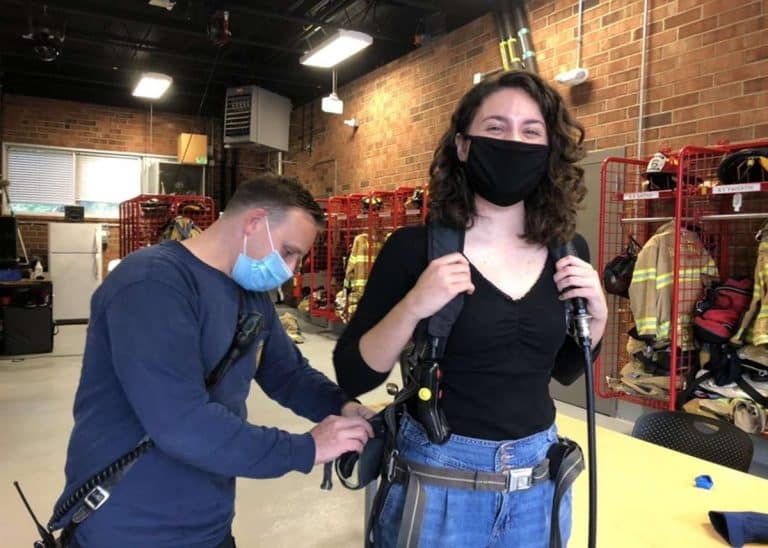The Industrial Design Program at NCSU conducts a suite of programs designed to get students out of the studio and into the community. By working with community members, the students learn that their design skills can make a difference in the lives of those around them.
One of these initiatives is Industrial Design Community Contact, in which students visit and interview community members about the physical challenges they encounter in their work lives. The students ask the workers about physical tasks that they find cumbersome, tiring, frustrating or painful. Collecting this first-hand testimony has provided a rich supply of design challenges for the ID students to tackle. Over the years, the students have interviewed sports therapists, teachers at a school for the blind, directors of a school for young adults with Autism, dentists, a support group for people with arthritis and fibromyalgia, restaurant owners and Emergency Medical Service workers, just to name a few.
In the Fall of 2020, under the shadow of COVID-19, the sophomore Industrial Design studio was understandably limited in the businesses that would welcome a visit from 20 University students. So, they approached an establishment that traditionally welcomes walk-ins, the local Fire Department. Respecting the chain of command, the students first called the City’s District Fire Chief who contacted the neighborhood Fire Station to arrange for the student visit. To reduce the chance of COVID transmission, only 6 of the students were permitted to visit the station. Once there with masks well placed, the students opened their laptops and connected with the rest of the studio by Zoom. The 10 firefighters and 6 students separated themselves into smaller groups to get finer grained responses from the firefighters.

The students prepared questions like:
- What tools/equipment do you carry with you on a regular basis?
- When you get a call, what must you do prior to leaving?
- What tool would you not enter a fire without?
- What is the hardest tool to use and why?
- What part of your activity is most fatiguing?
- What is the most dangerous part of your job?
The firefighters gave the students a tour of the firetrucks, demonstrated the use of their equipment and showed the practiced method of putting on their heavy turnout gear and boots. During the interviews, the students learned among other things that firefighters respond to all 911 calls whether they are fire-related or not. This is because, in the community of this fire station, there is a 3-minute response time for firetrucks as opposed to a 17-minute response time for EMS vehicles due to the location of the stations. Of course, the firefighters are trained to provide basic EMS assistance while awaiting the arrival of the ambulance. The students learned also that each firefighter has personalized his own turnout gear and helmet so that special tools that the firefighter favors can be attached to easily accessible parts of the body. The students were surprised to learn that the most frightening calls the firefighters respond to are traffic accidents, because once on the scene, they must watch for other motorists who do not slow down as they are passing through the firefighters’ work zone.
The students made video recordings of the interviews and took notes to put into a Google Drive folder so the entire studio could benefit. With this information in hand, the students began their research online to learn if any efforts had been made before to address their firefighters’ concerns. They investigated what equipment was available and how it served the work of the firefighter. After listing the pros and cons of the currently available equipment, the students undertook to improve, redesign, or replace the indicated equipment to satisfy the needs of the firefighters they had interviewed.
After describing through sketch and 3-D model their proposed solutions, the students met with the firefighters again to hear their feedback on the choices the students had made. Some product solutions received enthusiastic approval, while other solutions, the firefighters explained, would not function well under their working conditions. The students accepted the feedback and made the appropriate adjustments.
At the end of the project, the firefighters were treated to a final Zoom presentation from each student. The purpose was not only for the students to hear the final evaluations from the firefighters, but to give a sense of completion and satisfaction to the firefighters for their valuable collaboration throughout the project. Several students got their well-earned reward when they heard the firefighters comment about their project, “I could use that right now!”
Among the products the students designed were:
- A redesigned Haligan (a combination axe, pick and crowbar commonly used by firefighters)
- A gas-sensing respirator mask with heads-up, face-shield display
- A quick-access bailout rope bag to aid a rapid exit through an upper story window
- An instant wall-mounting electronic beacon with in-mask receiver to mark the way out when smoke makes visibility low
- A portable firefighters’ shower for on-site carcinogen removal.
- A body-mounted fire hose nozzle to keep loose fire hoses from causing damage or injury